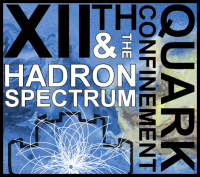Speaker
Description
Summary
X(4140), exotic meson, was experimentally observed by several collaborations in the invariant mass spectrum of $J/\psi \phi$, and very recently its quantum numbers are announced to be $J^{PC}=1^{++}$ by LHCb. However the decay width of the state observed by LHCb is unexpectedly wider then the previous observations. Despite these observations, its structure has not been totally understood yet, as well as other exotic mesons. In literature, its claimed that X(4140) might be a scalar, axial-vector or a tensor meson, with positive charge conjugation, which might be a $D_s^*\bar{D}_s^*$ molecule or a tetraquark state.
In this work, we chose three molecule, and three tetraquark currents, which can couple to X(4140), with $J^{PC}=0^{++},1^{++},2^{++}$, and analysed the masses and the decay constants of the ground states coupling to these currents in the framework of QCD sum rules. In OPE, we considered terms including dimension eight, and we did pole contribution tests carefully. According to our results, five of these currents couple to ground states with degenerate masses which are in 10MeV vicinity of X(4140) , while the axial vector tetraquark current estimates a ground state with a mass which is at least 30 MeV higher then $D_s^*\bar{D}_s^*$ threshold. Therefore, we conclude that, if X(4140) has a dominant molecular content, then there are three states degenerate in mass, with $C=+1$, and different isospins. On the other hand, pole contribution studies estimates noticeable changes in the correlation function between 4-6 GeVs. Therefore we conclude that, X(4140) should be investigated more, by studying its decays, and by other approaches as well.
